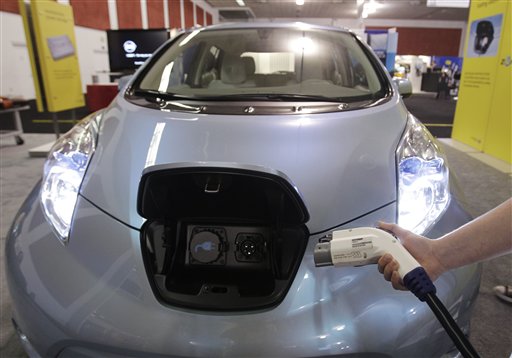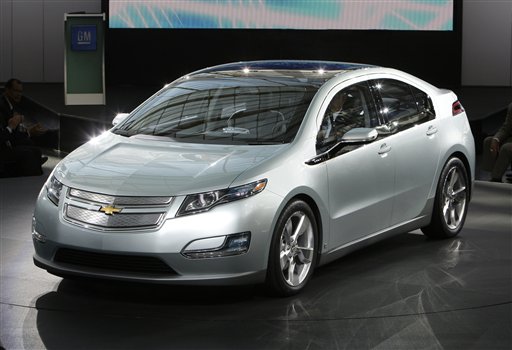 New York – The first mass-market electric cars go on sale next month, and the nation’s electric utilities couldn’t be more thrilled — or worried.
New York – The first mass-market electric cars go on sale next month, and the nation’s electric utilities couldn’t be more thrilled — or worried.
Subscribe to our Daily Roundup Email
Plugged into a socket, an electric car can draw as much power as a small house. The surge in demand could knock out power to a home, or even a neighborhood. That has utilities in parts of California, Texas and North Carolina scrambling to upgrade transformers and other equipment in neighborhoods where the Nissan Leaf and Chevrolet Volt are expected to be in high demand.
Not since air conditioning spread across the country in the 1950s and 1960s has the power industry faced such a growth opportunity. Last year, Americans spent $325 billion on gasoline, and utilities would love even a small piece of that market.
The main obstacles to wide-scale use of electric cars are high cost and limited range, at least until a network of charging stations is built. But utility executives fret that difficulties keeping the lights on for the first crop of buyers_and their neighbors_could slow the growth of this new niche.
“You never get a second chance to make a first impression,” says Mike Rowand, who is in charge of electric vehicle planning at Duke Energy.
Auto executives say it’s inevitable that utilities will experience some difficulties early on. “We are all going to be a lot smarter two years from now,” says Mark Perry, director of product planning for Nissan North America.
Electric cars run on big batteries that are charged by plugging into a standard wall socket or a more powerful charging station. A combined 30,000 Nissan Leafs and Chevrolet Volts are expected to be sold over the next year. Over the next two years, Ford, Toyota and every other major automaker also plan to offer electric cars.
Governments are promoting the expensive technology as a way to reduce dependence on foreign oil, cut greenhouse gas emissions and improve air quality. Congress is offering electric car buyers a $7,500 tax credit and some states and cities provide additional subsidies that can total $8,000. The Leaf sells for $33,000 and the Volt sells for $41,000.
Electric cars produce no emissions, but the electricity they are charged with is made mostly from fossil fuels like coal and natural gas that do. Still, electric cars produce two-thirds fewer greenhouse gas emissions, on average, than a similarly sized car that runs on gasoline, according to the Natural Resources Defense Council.
Driving 10,000 miles on electricity will use about 2,500 kilowatt-hours, or 20 percent more than the average annual consumption of U.S. homes. At an average utility rate of 11 cents per kilowatt-hour, that’s $275 for a year of fuel, equivalent to about 70 cents per gallon of gasoline.

“Electric vehicles have the potential to completely transform our business,” says David Owens, executive vice president of the Edison Electric Institute, a trade group.
Nationwide, utilities have enough power plants and equipment to power hundreds of thousands of electric cars. Problems could crop up long before that many are sold, though, because of a phenomenon carmakers and utilities call “clustering.”
Electric vehicle clusters are expected in neighborhoods where:
— Generous subsidies are offered by states and localities
— Weather is mild, because batteries tend to perform better in warmer climates
— High-income and environmentally conscious commuters live
So while states like North Dakota and Montana may see very few electric cars, California cities like Santa Monica, Santa Barbara and Monrovia could see several vehicles on a block. SoCal Edison expects to be charging 100,000 cars by 2015. California has set a goal of 1 million electric vehicles by 2020.
Progress Energy is expecting electric car clusters to form in Raleigh, Cary and Asheville, N.C. and around Orlando and Tampa, Fla. Duke Energy is expecting the same in Charlotte and Indianapolis. The entire territory of Texas’ Austin Energy will likely be an electric vehicle hot spot.
Adding an electric vehicle or two to a neighborhood can be like adding another house, and it can stress the equipment that services those houses. “We’re talking about doubling the load of a conventional home,” says Karl Rabago, who leads Austin Energy’s electric vehicle-readiness program. “It’s big.”
How big depends on the size of the battery in the car, and how fast the car is charged.
When plugged into a standard 120-volt socket, the electric car will draw 1,500 watts. By comparison, a medium-sized air conditioner or a countertop microwave oven will draw about 1,000 watts.
But the car can be charged faster, and therefore draw more power, when plugged into a home charging station. The first Leafs and Volts can draw 3,300 watts, and both carmakers may boost that to 6,600 watts soon. The Tesla Roadster, an electric sports car with a huge battery, can draw 16,800 watts. That’s the equivalent of 280 60-watt light bulbs.
A modest home in the San Francisco Bay area that doesn’t need air conditioning might draw 3,000 watts at most.
Transformers that distribute power from the electrical grid to homes are often designed to handle fewer than a dozen. Extra stress on a transformer from one or two electric vehicles could cause it to overheat and fail, knocking out power to the block.
The “nightmare” scenario, according to Austin Energy’s Rabago: People come home from work on a hot afternoon, turn on the air conditioner and the plasma television, blend some frozen cocktail, start cooking dinner on an electric stove —and plug their car into a home charging station.
An electric vehicle plugged into a standard wall socket poses a different problem. It will put less stress on a transformer, but it could trip a circuit breaker if the circuit serves other appliances. Power would go off in part of the house.
To head off problems, teams of workers at utilities are gathering information from Nissan and Chevrolet, doing customer surveys and looking at buying patterns of hybrid gas-electric cars like the Toyota Prius to try to predict where they might see clusters of electric car buyers.
They are comparing that data with maps of their systems to determine what equipment might need upgrading first in hopes of avoiding blown circuits in the neighborhoods of early buyers.
Utilities also hope to convince drivers to program their cars to charge late at night, when rates are low and most appliances are switched off.
Ted Craver, the chief executive of the parent company of SoCal Edison and a chairman of an industry electric vehicle planning association, says early buyers will likely be tolerant of a few hiccups. At the same time, he says, those are the people utilities should try hard to please. “They turn into promoters,” he says.
Replacing a neighborhood transformer costs a utility between $7,000 and $9,000, according to SoCal Edison. This is work a utility will often want to do. With the approval of public utility commissions, utilities can add the cost of these kinds of upgrades to the rates they charge customers across their territory.
Utility executives hope the popularity of electric cars will grow as the vehicles’ costs come down and as public charging stations are made available at malls and along highways. Momentum will gather faster, they predict, if they minimize the number of home circuits that get blown and neighborhood transformers that get fried over the next two years. But they know there will be problems.
“It’s like you’re about to have a baby,” says Duke Energy’s Rowand. “You know it’s going to be good, but you also know there’s going to be some throw up and some dirty diapers, and you just hope that it’s something you are prepared for.”

The only downside is that in many states, those few who do not purchase electric cars, will be paying some higher electric rates since the costs of upgrading the system to handle the charging will be “socialized” and rolled into to the rates paid by all customers. I think we would all be willing to pay a few dollars a month in higher utility rates to promote the use of this technology and reduce the problem of global warming.
Im all for.
we get gas from the arabs, not electricity
cost of electric will be next to sky rocket…
Good. We reached peak oil in this country right on schedule in the 1970s. If we haven’t reached peak oil worldwide already – the USGS, the Petroleum Institute, the DOE, the oil companies and the US military seems to think we have – we will in a year or two. Gasoline is only going to get more expensive. It will never be cheap again.
With electric cars we aren’t tied to petroleum. Whatever energy source comes online can be converted into electricity and transported cheaply to the charging station, certainly more cheaply than putting it in trucks and hauling it all over the country.
Electric cars aren’t as convenient as gasoline powered ones. They don’t currently have the range, and they’re more expensive. It’s to be expected since we’ve already used up the cheap, easy sources of power. But that will change as more of the fleet is electric.
Lets see, call this “green” because you use electric to drive your souped up lawnmower 50 miles to the 8 hour or more charge. But where are they getting the electricity from to charge these things???
COAL!! DIRTY COAL!! EVIL COAL!!!